NASA: Expedition 64 JAXA 6 Month Challenge Campaign, Story Time From Space Willow The Water Bear Book, SpaceCast Weekly, Countdown to Mars, and Perseverance Arrives at Mars
NASA: Expedition 64 JAXA 6 Month Challenge Campaign – January 28, 2021,
Expedition 64 Story Time From Space Willow The Water Bear Book – January 26, 2021,
SpaceCast Weekly – January 29, 2021,
Countdown to Mars: A Story of Perseverance, Sep 14, 2020,
Perseverance Arrives at Mars: Feb. 18, 2021 (Mission Trailer), Dec 21, 2020,
NASA Jet Propulsion Laboratory
Mars Science Laboratory and Its Payload Fairing and The Latest Images
Expedition 64 JAXA 6 Month Challenge Campaign – January 28, 2021
Jan 28, 2021 NASA Video
SPACE STATION CREW MEMBER CONDUCTS EDUCATIONAL CHALLENGE WITH JAPANESE
STUDENTS Aboard the International Space Station, Expedition 64 Flight Engineer Soichi Noguchi of the Japan Aerospace Exploration Agency (JAXA) answered questions about life and work on the outpost Jan. 28 submitted by Japanese students involved in a “6 Month Mission Challenge” educational activity. Noguchi arrived on the station in November aboard the SpaceX Crew Dragon spacecraft “Resilience” for a six-month mission of scientific research.
Expedition 64 Story Time From Space Willow The Water Bear Book – January 26, 2021 NASA Video
SPACE STATION CREW MEMBER PLAYS THE ROLE OF STORY TELLER Aboard the International Space Station, Expedition 64 Flight Engineer Shannon Walker of NASA played the role of story teller Jan. 26 as she read the children’s book “Willow the Water Bear” to students back on Earth from the orbital outpost. The book reading event was part of an educational STEM and literacy project sponsored as a payload activity by the Marshall Space Flight Center in Huntsville, Alabama. Walker also answered questions about life and work on the complex submitted by students as part of the education
SpaceCast Weekly – January 29, 2021
Jan 29, 2021 NASA Video
SpaceCast Weekly is a NASA Television broadcast from the Johnson Space Center in Houston featuring stories about NASA’s work in human spaceflight, including the International Space Station and its crews and scientific research activities, and the development of Orion and the Space Launch System, the next generation American spacecraft being built to take humans farther into space than they’ve ever gone before. Video produced at the NASA Johnson Space Center
Countdown to Mars: A Story of Perseverance
Sep 14, 2020 NASA
“When you look at the team that put this robot together, and the team that put this launch vehicle together, that’s what they’ve done. They’ve persevered.” Go behind the scenes of our Perseverance Mars rover’s July 30, 2020 launch with NASA Administrator Jim Bridenstine. On Feb. 18, 2021, the rover will land in Jezero Crater, Mars, where it will search for signs of ancient life.
Perseverance Arrives at Mars: Feb. 18, 2021 (Mission Trailer)
Dec 21, 2020 NASA Jet Propulsion Laboratory
After nearly 300 million miles (470 million km), NASA’s Perseverance rover completes its journey to Mars on Feb. 18, 2021. But, to reach the surface of the Red Planet, it has to survive the harrowing final phase known as Entry, Descent, and Landing.
Learn more: https://mars.nasa.gov/mars2020? Credit: NASA/JPL-Caltech
PIA15029: Mars Science Laboratory and Its Payload Fairing
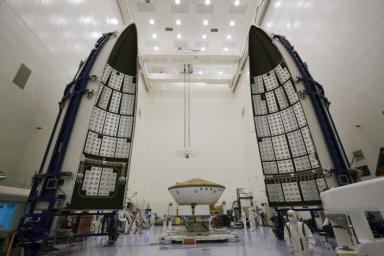 Original Caption Released with Image:
Original Caption Released with Image:
Preparations are under way to enclose NASA’s Mars Science Laboratory in
an Atlas V rocket payload fairing in this photograph from inside the Payload
Hazardous Servicing Facility at NASA’s Kennedy Space Center in Florida.
The blocks on the interior of the fairing are components of the fairing acoustic
protection system, designed to protect the payload by dampening the sound
created by the rocket during liftoff. The fairing protects the spacecraft from the
impact of aerodynamic pressure and heating during ascent.
The spacecraft’s components include a car-sized rover, Curiosity, which has
10 science instruments designed to search for evidence about whether
Mars has had environments favorable to microbial life, including the chemical
ingredients for life.
Launch of the Mars Science Laboratory aboard a United Launch Alliance Atlas
V rocket is planned for Nov. 25 from Space Launch Complex 41 on Cape
Canaveral Air Force Station.
NASA’s Jet Propulsion Laboratory, a division of the California Institute of
Technology in Pasadena, manages the Mars Science Laboratory Project
for NASA’s Science Mission Directorate in Washington. Launch management
is the responsibility of NASA’s Launch Services Program at the Kennedy
Space Center in Florida. The Atlas V launch service is provided by
United Launch Alliance, Denver, Colo.
Image Credit: NASA
Image Addition Date: 2011-11-10
| PIA14758: Mars Science Laboratory Aeroshell with Curiosity Inside |
At the Payload Hazardous Servicing Facility at NASA’s Kennedy Space Center in Florida, the Mars Science Laboratory rover, Curiosity, and the spacecraft’s descent stage have been enclosed inside the spacecraft’s aeroshell. This image, taken Oct. 1, 2011, shows the aeroshell with its heat shield on top. The heat shield and the spacecraft’s back shell together form the encapsulating aeroshell that will protect the rover from the intense heat that will be generated as the flight system descends through the Martian atmosphere. The mission is on track for launch from Cape Canaveral Air Force Station during the period from Nov. 25 to Dec. 18, 2011.
The Jet Propulsion Laboratory, a division of the California Institute of Technology
in Pasadena, manages the Mars Science Laboratory mission for the NASA Science
Mission Directorate, Washington. This mission will land Curiosity on Mars in
August 2012. Researchers will use the tools on the rover to study whether the landing region has had environmental conditions favorable for supporting microbial life and favorable for preserving clues about whether life existed.
More information about Curiosity is at http://mars.jpl.nasa.gov/msl/.
Image Credit: NASA/JPL-Caltech
Image Addition Date: 2011-10-05
PIA14837: Curiosity While on Parachute, Artist’s Concept
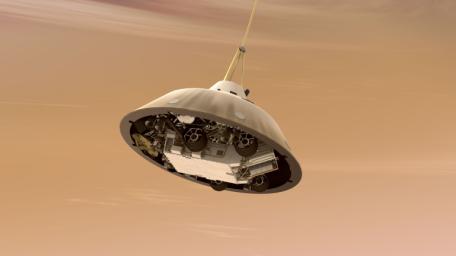 Original Caption Released with Image:
Original Caption Released with Image:
| This is an artist’s concept of NASA’s Curiosity rover tucked inside the Mars Science Laboratory spacecraft’s backshell while the spacecraft is descending on a parachute toward Mars. The parachute is attached to the top of the backshell. In the scene depicted here, the spacecraft’s heat shield has already been jettisoned.
The Mars Science Laboratory spacecraft is being prepared for launch during Nov. 25 to Dec. 18, 2011. Landing on Mars is in early August 2012. In a prime mission lasting one Martian year (nearly two Earth years) researchers will use the rover’s tools to study whether the landing region has had environmental conditions favorable for supporting microbial life and for preserving clues about whether life existed. NASA’s Jet Propulsion Laboratory, a division of the California Institute of Technology, Pasadena, Calif., manages the Mars Science Laboratory Project for the NASA Science Mission Directorate, Washington. More information about Curiosity is at http://mars.jpl.nasa.gov/msl/. Image Credit: NASA/JPL-Caltech Image Addition Date: 2011-10-03
|
| PIA14267: Special Delivery from Mars to Earth (Artist’s Concept) |
 Original Caption Released with Image:This artist’s concept of a proposed Mars sample return mission portrays the separation of an Earth entry vehicle, bearing a container of Martian rock samples, from the main spacecraft that would have carried it from Martian orbit nearly to Earth.
Original Caption Released with Image:This artist’s concept of a proposed Mars sample return mission portrays the separation of an Earth entry vehicle, bearing a container of Martian rock samples, from the main spacecraft that would have carried it from Martian orbit nearly to Earth.
NASA and the European Space Agency are collaborating on proposals for a mission to gather samples of Martian rocks and bring them to Earth after 2020. This illustration depicts preliminary concepts, not finished design.
Image Credit: NASA/JPL-Caltech
Image Addition Date: 2011-06-20
This artist’s concept of a proposed Mars sample return mission portrays a rocket-powered descent stage lowering a sample-retrieving rover and an ascent vehicle to the surface. The ascent vehicle is in the large cylinder, protecting it from the harsh Martian environment. The rover, with solar-panels in folded position, sits to the right of it. The ascent vehicle would receive samples of Martian rocks that are to be collected by a previous mission and retrieved by the rover. Then it would launch the samples into Martian orbit for a rendezvous with a spacecraft that would carry them to Earth. NASA and the European Space Agency are collaborating on proposals for a mission to gather samples of Martian rocks and bring them to Earth after 2020. This illustration depicts preliminary concepts, not finished design. Image Credit: NASA/JPL-Caltech Image Addition Date: 2011-06-20 For more information, please visit the following links: https://photojournal.jpl.nasa.gov/gallery/snt?start=0 https://photojournal.jpl.nasa.gov/catalog/PIA14264 PIA24390: Spring Sprouts on Mars The sun is rising in Mars’ Northern Hemisphere, and spring activity is starting as the seasonal polar cap begins to sublimate (going from ice directly to gas). A layer of dry ice covers the sand dunes in this image. Gas jets sprout through the ice layer carrying dust and sand from the surface, showing up as dark fans. At this time in early Martian spring, the fans are visible between the sand dunes. The ground between the dunes is on the scale of tens of centimeters, and ice in places where the sun hits more directly will thin fastest, releasing the jets. Later, the ice over and around the dunes will rupture and more fans will appear on the dunes. The map is projected here at a scale of 50 centimeters (19.7 inches) per pixel. (The original image scale is 63.4 centimeters [25.0 inches] per pixel [with 2 x 2 binning]; objects on the order of 190 centimeters [74.8 inches] across are resolved.) North is up. The University of Arizona, in Tucson, operates HiRISE, which was built by Ball Aerospace & Technologies Corp., in Boulder, Colorado. NASA’s Jet Propulsion Laboratory, a division of Caltech in Pasadena, California, manages the Mars Reconnaissance Orbiter Project for NASA’s Science Mission Directorate, Washington. Image Credit: NASA/JPL-Caltech/University of Arizona
PIA24383: Stepping It Up in Arabia Terra
Several craters in Arabia Terra are filled with layered rock, often exposed in rounded mounds. The bright layers are roughly the same thickness, giving a stair-step appearance. The process that formed these sedimentary rocks is not yet well understood. They could have formed from sand or volcanic ash that was blown into the crater, or in water if the crater hosted a lake. One thing is certain, though: it wouldn’t be hard to get your 10,000 daily steps when going on a hike in beautiful Arabia Terra! The map is projected here at a scale of 25 centimeters (9.8 inches) per pixel. (The original image scale is 27.6 centimeters [10.9 inches] per pixel [with 1 x 1 binning]; objects on the order of 83 centimeters [32.7 inches] across are resolved.) North is up. The University of Arizona, in Tucson, operates HiRISE, which was built by Ball Aerospace & Technologies Corp., in Boulder, Colorado. NASA’s Jet Propulsion Laboratory, a division of Caltech in Pasadena, California, manages the Mars Reconnaissance Orbiter Project for NASA’s Science Mission Directorate, Washington. Image Credit: NASA/JPL-Caltech/University of Arizona
PIA24382: Blast Waves and Dusty Landslides Meteorites hit Mars and create small craters like the one we’ve imaged here. Usually we spot these new craters in lower-resolution images from the Context Camera because the impact disturbs dust on the surface and creates a dark mark that’s much bigger than the crater. This meteorite hit a dusty area and made a crater, but did something a little more special to the surrounding dust. We can see dozens of dark, dust-free, streaks on slopes surrounding the crater. These slope streaks form when dust slumps downhill and happen naturally on a regular basis. In this case though, the impact and explosion that made the crater seems to have set off many of these downhill slumps of dust simultaneously. This could have happened from the explosion’s blast wave passing through the air or the shaking of the ground that it caused. The map is projected here at a scale of 25 centimeters (9.8 inches) per pixel. (The original image scale is 31.2 centimeters [12.3 inches] per pixel [with 1 x 1 binning]; objects on the order of 93 centimeters [36.6 inches] across are resolved.) North is up. This is a stereo pair with ESP_065360_1900. The University of Arizona, in Tucson, operates HiRISE, which was built by Ball Aerospace & Technologies Corp., in Boulder, Colorado. NASA’s Jet Propulsion Laboratory, a division of Caltech in Pasadena, California, manages the Mars Reconnaissance Orbiter Project for NASA’s Science Mission Directorate, Washington. Image Credit: NASA/JPL-Caltech/University of Arizona
PIA24378: Mars 2020 Camera and Microphone Location (Illustration) This graphic shows the location of four cameras and a microphone on the spacecraft for NASA’s Mars 2020 Perseverance mission. These cameras will capture the entry, descent, and landing phase of the mission. A division of Caltech in Pasadena, California, NASA’s Jet Propulsion Laboratory built and will manage operations of the Mars 2020 Perseverance rover for the agency. For more information about the mission, go to https://mars.nasa.gov/mars2020/ Image Credit: NASA/JPL-Caltech Image Addition Date: 2021-01-27 PIA24309: Exploring Majestic Jezero Crater (Illustration) An illustration of NASA’s Perseverance rover exploring inside Mars’ Jezero Crater. The 28-mile-wide (45-kilometer-wide) crater is located on the western edge of a flat plain called Isidis Planitia, which lies just north of the Martian equator. NASA believes the ancient lake-delta system there is the best place for Perseverance, in its hunt for signs of past microscopic life, to find and collect promising rock and regolith (broken rock and dust) samples for a possible future return to Earth. A key objective for Perseverance’s mission on Mars is astrobiology, including the search for signs of ancient microbial life. The rover will characterize the planet’s geology and past climate, pave the way for human exploration of the Red Planet, and be the first mission to collect and cache Martian rock and regolith. Subsequent missions, currently under consideration by NASA in cooperation with ESA (European Space Agency), would send spacecraft to Mars to collect these cached samples from the surface and return them to Earth for in-depth analysis. NASA’s Jet Propulsion Laboratory in Southern California built and manages operations of the Mars 2020 Perseverance rover for NASA. For more information about the mission, go to https://mars.nasa.gov/mars2020/. Image Credit: NASA/JPL-Caltech Image Addition Date: 2021-01-27 PIA24265: Perseverance’s Stages of Descent (Illustration) This illustration depicts the some of the major milestones NASA’s Perseverance rover will go through during its 7-minute descent to the Martian surface on Feb. 18, 2021. Hundreds of critical events must execute perfectly and exactly on time for the rover to land safely. Entry, Descent, and Landing, or EDL, begins when the spacecraft reaches the top of the Martian atmosphere, traveling nearly 12,500 mph (20,000 kph). It ends about seven minutes later, with Perseverance stationary on the Martian surface. Perseverance handles everything on its own during this process. It takes more than 11 minutes to get a radio signal back from Mars, so by the time the mission team hears that the spacecraft has entered the atmosphere, in reality, the rover is already on the ground. A key objective for Perseverance’s mission on Mars is astrobiology, including the search for signs of ancient microbial life. The rover will characterize the planet’s geology and past climate, pave the way for human exploration of the Red Planet, and be the first mission to collect and cache Martian rock and regolith. Subsequent missions, currently under consideration by NASA in cooperation with ESA (European Space Agency), would send spacecraft to Mars to collect these cached samples from the surface and return them to Earth for in-depth analysis. NASA’s Jet Propulsion Laboratory in Southern California built and manages operations of the Mars 2020 Perseverance rover for NASA. For more information about the mission, go to: https://mars.nasa.gov/mars2020. Image Credit: NASA/JPL-Caltech Image Addition Date: 2021-01-27
|


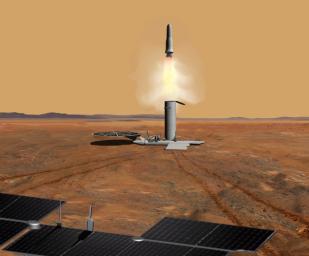
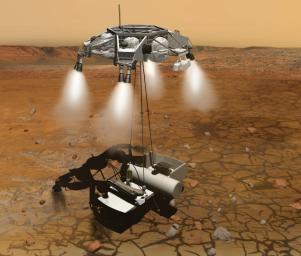



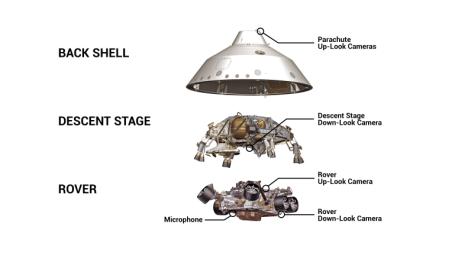

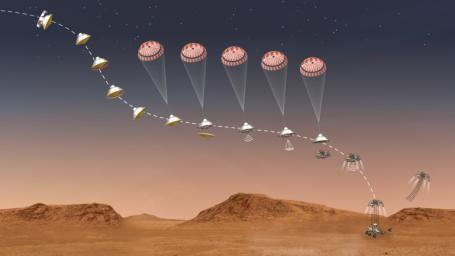
Leave a Reply